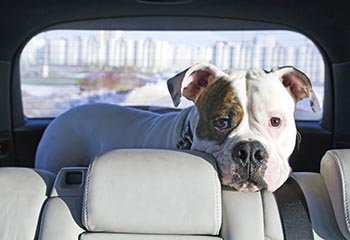Senior drivers who always take a pet in the car are at increased risk for being involved in a motor vehicle collision, said University of Alabama at Birmingham (UAB) researchers. In a study published in Accident Analysis and Prevention on May 2, 2013, the research team said both overall and at-fault crash rates for drivers 70 years of age or older were higher for those whose pet habitually rode with them.

“This is the first study to evaluate the presence of pets in a vehicle as a potential internal distraction for elderly drivers,” said Gerald McGwin, Ph.D., a professor in the Departments of Epidemiology, Ophthalmology and Surgery and senior author of the study. “The increased crash rate for elderly drivers who always drive with pets is important in the context of increasing driver awareness about potentially dangerous driving habits.”
Distracted driving has become a focal point for the National Highway Safety Traffic Administration and is defined as anything that could potentially remove a driver’s eyes from the road, their hands from the steering wheel or their concentration from the task of driving.
The authors report that cell phone use has received the most attention, which has led some states to enact legislation controlling their use. Currently Hawaii is the only state that specifically restricts drivers from having a pet in the lap. Arizona, Connecticut and Maine have broader laws restricting behavior or activities that could potentially distract a driver; such laws could be applicable to pets in a vehicle.
“There is no direct evidence that driving with pets is or is not a threat to public safety, however, indirect evidence exists based on distracted driving research on texting, eating or interacting with electronics or even other passengers,” said McGwin. “And there are certainly anecdotal reports in the news media of crashes and even fatalities caused by drivers distracted by a pet in the vehicle.”
|
The crash risk for drivers who always drove with their pets was double that of drivers who never drove with a pet, while crash rates for those who sometimes or rarely drove with pets were consistent with the rates for non-pet owners. |
The authors suggest that when confronted with an increased cognitive or physical workload while driving, elderly drivers have exhibited slower cognitive performance and delayed response times in comparison to younger age groups.
“Adding another distracting element, especially an active, potentially moving animal, provides more opportunity for an older driver to respond to a driving situation in a less than satisfactory way,” said McGwin. “Regulations in this area might be warranted, particularly if our findings are replicated by others.”
The study, conducted in the Clinical Research Unit in the UAB Department of Ophthalmology, enrolled 2,000 community-dwelling (those who do not live in assisted living or nursing homes) licensed drivers age 70 and older, of whom 691 had pets. Study subjects took a survey on driving habits, and those with pets were asked about the frequency of driving with pets. Participants also underwent visual sensory and higher-order visual processing testing.
The crash risk for drivers who always drove with their pets was double that of drivers who never drove with a pet, while crash rates for those who sometimes or rarely drove with pets were consistent with the rates for non-pet owners.
More than half the pet owners said they took their pet with them in the car at least occasionally, usually riding on the front passenger seat or in the back seat.
“That is consistent with previous studies looking at all drivers, which indicate that slightly more than half of all drivers take a pet with them at times,” said McGwin. “And it’s interesting to note that earlier surveys indicate that 83 percent of those surveyed agreed that an unrestrained dog was likely dangerous in a moving vehicle, yet only 16 percent have ever used any type of restraint on their own pet.”
Given the current debate about all types of distracted driving, the study authors suggest that further study of pet-related distracted driving behaviors among older drivers, as well as younger populations, with respect to driver safety and performance is warranted to appropriately inform the need for policy regulation on this issue.